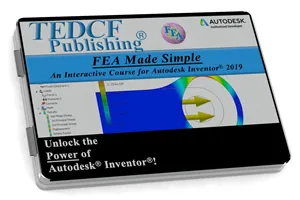Yes, you too can use Finite Element Analysis (FEA)!
Turn Inventor Simulation into a tool that enhances your productivity. The Inventor 2019: FEA Made Simple course does just that. It doesn't teach heavy mathematics. It teaches you how to use FEA efficiently. You'll learn how to confirm the accuracy of your study results by using simple methods to calculate them, the details about the data you input into your simulations, the details about operations applied to data, and you'll learn how simulation settings affect the quality of your study results.
Yes, you too can use Finite Element Analysis (FEA)! Many of our customers are not engineers and don't have a strong mathematical background. So you might think you can't effectively use Inventor's FEA module. That's simply not true.
You can use simple math and easy to understand procedures to assure your FEA simulation reports are accurate. You just need to learn what to look for and how to use the FEA module.
For the mathematical engineering geniuses reading this, we've got you covered as well. This course was written and produced by David Melvin, PE. He explains how to simplify complex stress analysis into simple to follow procedures. So there's plenty of opportunity for you to check his work. In the end Inventor's FEA module checks his work, which is the whole point.
Once you learn simple ways of estimating stress you can use them to confirm Inventor outputs reasonably accurate results. So the theme of this course is the same as for all our courses. You will learn how to feel confident about your work while streamlining the process and increasing productivity.
So this is a good opportunity to learn how to put the FEA module to good use.
58 Lessons (Listed Below)
5 hours of instruction
You can also browse through the lessons from the following Inventor 2019 courses and watch sample lessons.
Inventor 2019: Solid Modeling Inventor 2019: Assemblies and Advanced Concepts Inventor 2019: 2D Drafting and Customization Inventor 2019: Sheet Metal Design Inventor 2019: Tube and Pipe Routed Systems Inventor 2019: Inventor Studio Made Simple Inventor 2019: iLogic Made Simple Inventor 2019: Fea Made Simple Inventor 2019: Dynamic Simulation Made SimpleOur Inventor courses require No Installation. You can watch them on any device connected to the internet.
You will receive an email containing your User Name and Password. Login to your account and start learning. It's that easy.
While you're logged into your account you can download files used in the courses, watch lessons, and practice the tasks taught in the lessons. Keep in mind that you will use your installation of Inventor to practice.
Get your Inventor 2019 training now. You can start learning in minutes.
Autodesk Inventor® 2019:
FEA Made Simple
No Installation Required
Watch from any device connected to the internet.

$59.95 - $229.95
Watch Sample Lessons
Watch the first hour of the Solid Modeling course for Autodesk Inventor 2019.
 Click to Watch!
Click to Watch!FEA Made Simple
5 hours of instruction
Lessons
Introduction
Simulation Setup
Basic Static Simulation
Basic Static Simulation Results
Normal Stress
Shear and Normal Stresses
Components of Force
Principal Stress Intro
Controlling Probe Location
Mohr's Circle
Maximum Shear Stress
Principal Stresses
Von Mises Stress
Adjusting Element Size
Normal vs Von Mises
Calculating Bending Stress
Equivalent Moments and Forces
Misaligned Moments and Forces
Loads on Complex Parts
Simplifying Complex Loads
Couples and Moments
Common Sense Deduction
Torsion and Shear
Combined Loads and Stresses
Understanding Von Mises Stress
Point vs Area Loads
Mesh Elements
Optimizing Element Settings
Mesh Controls
Improving Meshes and Reports
Stress Risers
Stress Riser Design and Analysis
Element Size Convergence
Convergence Strategies
Safety Factor and Material Specs
Introduction to Reports
Stress Analysis Reports
FOS Brittle and Ductile
Force and Pressure Loads
Bearing vs Force Loads
Soft Spring Constraints
Soft Spring Comparison
Optimizing Designs Based on FEA
Parametric Dimension Tips
Frame Analysis Simulations
Torsional Section Modulus
Beam Analysis
Beam Details and Diagrams
Introduction to Trusses
Method of Joints
Force Propagation
Constraining Trusses
Releases in Detail
Truss Simulation Details
Shell Elements
Applying Contacts
Thin Wall Model Analysis
Conclusion
